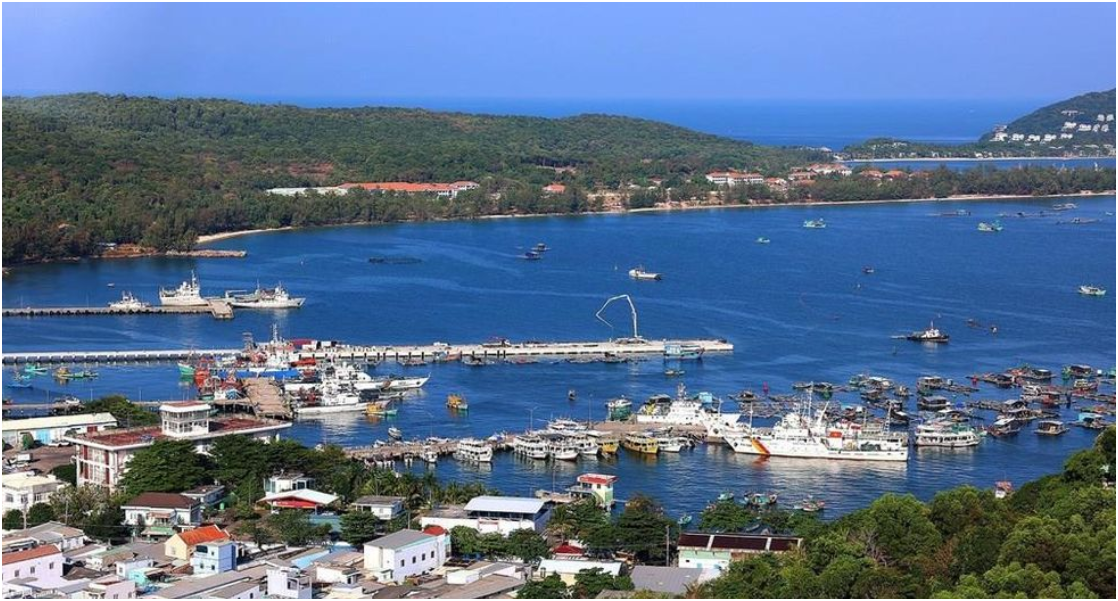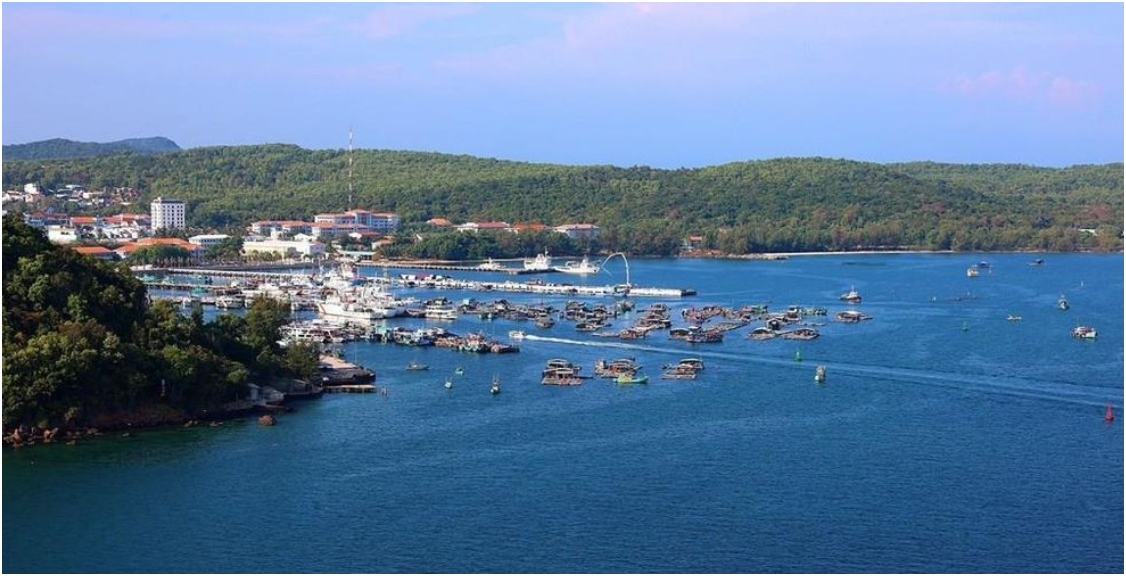
An Thoi Port, Phu Quoc. Photo: Duong Giang-VNA
In investing in synchronous and modern infrastructure, Phu Quoc focuses on developing the port and wharf system on the island with many strategic goals, contributing to creating momentum for local socio-economic development and protecting the sacred sovereignty of the sea and islands of the Fatherland.
Current status of port and wharf systems
According to Decision No. 1579/QD-TTg dated September 22, 2021 and Decision No. 442/QD-TTg dated May 22, 2024 of the Prime Minister on the master plan for the development of Vietnam's seaport system in the period 2021 - 2030, with a vision to 2050, Kien Giang seaport (old) now An Giang province belongs to seaport group No. 5; in which, the land and water area of Phu Quoc island is planned to serve the socio-economic development of Phu Quoc special zone, with an international passenger terminal combined with general cargo handling, international passenger ships up to 225,000 GT, general ships up to 30,000 tons. An Thoi, Vinh Dam, Bai Vong, and Mui Dat Do ports have general wharves, liquid/gas cargo, passenger wharves, sea ferries, marinas, and ships up to 3,000 tons. The development of the port and wharf system in Phu Quoc is not simply about expanding transport infrastructure but also has many important strategic and economic goals.
According to the Department of Construction of An Giang province, Phu Quoc currently has an important port and wharf system, including: The International Passenger Port with a total investment of more than VND 1,644 billion was approved in 2015. The Department of Construction Investment Management - Ministry of Transport (now the Ministry of Construction) inspected and accepted the completion of the project according to regulations and approved in March 2024. The port has been announced by the Vietnam Maritime Administration to open the wharf and extend the exploitation period until June 30, 2025. However, the current difficulty is that the port's electronic chart must be updated by the United Kingdom Hydrographic Office (UKHO) to meet the requirements of international shipping lines.
Next, An Thoi Seaport, in January 2025, the Vietnam Maritime Administration handed over the port's maritime infrastructure assets to An Giang province for management and exploitation. Currently, An Thoi Seaport has degraded due to many years of disuse and the buoys no longer exist. An Giang Department of Construction is studying a port management and exploitation project to submit to the Provincial People's Committee for approval.
Regarding Bai Vong Port, in September 2024, Hoa Binh Ham Ninh Joint Stock Company paid full compensation and is carrying out management and exploitation activities, preparing to invest in items according to the planning.
At the same time, Vinh Dam Port is a general port for passengers and goods, construction materials managed and exploited by Toan Hai Van Joint Stock Company. The port has completed phase 1 items, but there are still many items that have not been completed such as: Dredging the channel (reef), building unapproved embankments, site clearance and land handover.
The port is 500 m long, with 5 wharves capable of receiving 1,500 DWT ships; 2 passenger wharves for 300-passenger speedboats and 1 ferry wharf for 300-passenger ships; cargo handling capacity from 1 - 1.5 million tons/year; warehouse area of 10,000 m² and cargo staging area of 250,000 m².
Mui Dat Do Wharf is planned with the following functions: General wharf, liquid/gas cargo, passenger wharf, sea ferry, marina; ship size up to 3,000 tons. However, this area has been planned to build works to serve the APEC 2027 Conference, so it is not possible to invest in the port according to regulations.
In addition, Bai Vong Hamlet area has 5 temporary wharves mainly serving the demand for construction materials supply and the Provincial People's Committee agreed to extend the operation until December 31, 2025. Specifically, Hong Ngoc temporary inland waterway wharf, with the capacity to receive 3,500 DWT vehicles, 2 million tons of goods/year; Phu Thanh temporary inland waterway wharf, with the capacity to receive 1,800 DWT vehicles, 720,000 tons of goods/year; Vo Va temporary inland waterway wharf, with the capacity to receive 1,800 DWT vehicles, 219,000 tons of goods/year; two temporary inland waterway terminals Hoa Binh and Quoc Chanh, with ferries serving passengers and transporting goods and cars on the Ha Tien - Phu Quoc and Rach Gia - Phu Quoc routes.
Phu Quoc invests in developing a port system on the island, aiming to expand connectivity, promote socio-economic development and affirm its international position. The port system not only helps the Pearl Island circulate goods but also creates an urban highlight, promotes sea tourism services, combines economic development with ensuring national defense and security, towards a modern, dynamic and integrated coastal city.
Important economic strategic goals

An Thoi Port, Phu Quoc. Photo: Duong Giang-VNA
The leaders of An Giang province emphasized that developing the port system on Phu Quoc island will implement the important strategic and economic goals of the special zone, promote trade and tourism, especially the capacity to receive large international cruise ships, open up opportunities to develop high-end sea tourism and global connectivity; connect the island with the mainland, increase maritime transport capacity, create momentum for socio-economic development, and contribute to protecting the sovereignty of the sea and islands.
Deputy Director of An Giang Department of Construction Dao Huy Hiep said that Phu Quoc special zone has about 321 valid investment projects in the planning areas; of which, there are 268 projects under construction and will be implemented, the demand for construction materials is about 7.5 million tons/year; of which, the demand for construction materials for APEC 2027 projects is about 5 million tons/year, stone materials are about 4.8 million m³. In addition, the number of passengers traveling to and from Phu Quoc by sea is an average of 6,000/day, in addition, there are also a large number of cars transported back and forth at temporary wharves. Thus, the demand for transporting construction materials, goods and passengers in Phu Quoc special zone is very large. The natural conditions of Phu Quoc sea area are very favorable for receiving large tonnage ships and the larger the cargo transportation by waterway means, the lower the product cost, contributing to bringing the cost of construction materials between the mainland and Phu Quoc island closer together, in order to reduce costs for investors, attract investment, and accelerate the development of Phu Quoc special economic zone. However, the current status of port and wharf infrastructure in this special economic zone still has many shortcomings, requiring drastic, synchronous and timely solutions for more effective exploitation and use. Typically, Vinh Dam port, which has not been completed yet, needs to focus on accelerating the investment progress to complete it soon, contributing to promptly meeting the development requirements of Phu Quoc special economic zone. Next, the province proposed that the Ministry of Construction adjust and supplement the Master Plan for the development of Vietnam's seaport system for the period 2021 - 2030, with a vision to 2050, the temporary ports in Bai Vong area in the direction of expansion, increasing capacity, with general ports, passenger ports, bulk cargo, liquid/gas cargo, serving the socio-economic development of An Giang province, Phu Quoc special economic zone and contributing to the development of the marine economy in the Mekong Delta. Recently, during a survey of the port and wharf system on Phu Quoc island, Deputy Minister of Construction Nguyen Xuan Sang requested An Giang province and Phu Quoc special economic zone to urgently develop a plan to effectively exploit An Thoi international passenger port - a key transport infrastructure project that has been handed over by the Ministry. At the same time, it is recommended that the provincial authorities review and rectify port operations, ensure safety and security for vehicles and passengers, serve tourism, transport passengers and goods, and construction materials, especially for APEC 2027.